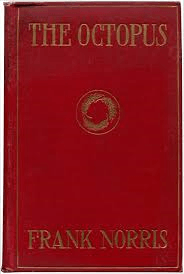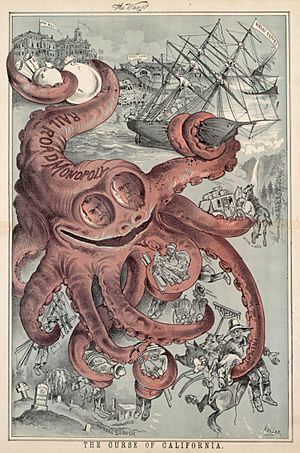The Octopus: A Story of California facts for kids

First edition
|
|
| Author | Frank Norris |
|---|---|
| Country | United States |
| Language | English |
| Series | Epic of Wheat trilogy |
| Genre | Novel |
| Publisher | Doubleday, Page |
|
Publication date
|
1901 |
| Media type | Print (Hardback & Paperback) |
| OCLC | 244815 |
| Followed by | The Pit |
The Octopus: A Story of California is an exciting novel written by Frank Norris in 1901. It was planned as the first part of a three-book series called The Epic of the Wheat. This story is all about the huge wheat farms in California and the big problems that happen between the wheat farmers and a powerful railway company.
Frank Norris got the idea for this book from a real-life event called the Mussel Slough Tragedy. This event involved a railway company, the Southern Pacific Railroad, and led to serious disagreements. In the novel, Norris shows the strong tensions between the railway company, the ranchers (farmers), and a group the ranchers formed called the League.
How the Story Began
After his book McTeague became popular in 1899, Frank Norris started looking for a new idea. Within a few weeks, he thought of writing a series of three novels about wheat. He called this big project his 'Epic of the Wheat'.
The first book, The Octopus, would be about growing wheat in California. The second book, The Pit (published after he passed away in 1903), would be about selling wheat in Chicago. The third book, which he planned to call The Wolf, was meant to be about people eating wheat in a hungry part of Europe or Asia, but he never got to write it.
The Octopus was inspired by the Mussel Slough Tragedy that happened in 1880. This was a serious conflict between ranchers and law enforcement who were protecting the Southern Pacific Railroad. The main problem was who owned the land. The farmers had been renting the land from the railroad for almost ten years, hoping to buy it later. The railroad had first offered the land for a low price, but then they decided to sell it for much more, based on how much the farmers had improved the land. This led to the big conflict you read about in the book.
Norris decided to write this story in March 1899. By early April, he traveled to California to do his research. For several months, he visited the places where the real events happened. He even worked on nearby farms himself. This helped him understand what life was like for a wheat farmer.
He went back to New York that fall. Between January and December 1900, he wrote the entire book, The Octopus. It was published the next April and became very successful.
What Happens in the Story
The Octopus shows the big fight between wheat farmers in California's southern San Joaquin Valley and a made-up railway company called the Pacific and Southwestern railroad (P&SW). The main town nearby is called Bonneville.
The farmers' group, the League, tries to influence state politicians. They even try to get Lyman, Magnus Derrick's lawyer son, a spot on the railroad's board. But it doesn't work out because the railroad secretly supports Lyman's plan to become governor. Lyman then breaks his promise to the League and doesn't lower the shipping prices for wheat from Tulare County.
Dyke, who used to work for the railroad, loves his daughter, Sidney, and his mother very much. Dyke loses his job because he wouldn't accept less money. He decides to grow hops, but his plans are ruined when the railroad raises the price for shipping them. After taking desperate actions, he tries to escape but is eventually caught.
When the community gathers to chase jack rabbits from Osterman's ranch, agents from the railroad, Behrman, Delaney, and Christia, along with U.S. marshals, take over Annixter's ranch. Other members of the League ride off to stop Derrick's ranch from being taken. In a gunfight that follows, Osterman, Broderson, Harran Derrick (Magnus's son), and Hooven are all killed or badly hurt.
Later, Presley, a poet, throws a bomb into Behrman's home, but Behrman is not hurt.
At a meeting in the Bonneville opera house, other League members suggest being careful. Derrick arrives and is about to speak when newspapers are handed out. The front page reveals Derrick's involvement in the League's attempts to influence politicians. Derrick's reputation is ruined.
Dyke is put on trial and sent to prison for life.
Mrs. Hooven and her daughters, Minna and Hilda, move to San Francisco. They get separated and become very poor. Mrs. Hooven becomes very ill and passes away. Presley tries to help them but arrives too late.
In San Francisco, Presley attends a fancy dinner with his businessman friend, Cedarquist. Cedarquist helps Presley get a spot on a ship going to India. Cedarquist's wife is touched by Presley's poem 'The Toilers'. She raises money to send a ship full of wheat to help people suffering from hunger in India.
Behrman, who now owns Derrick's farm, harvests the wheat Derrick grew. He sells it to Mrs. Cedarquist's effort to help those in need. He goes to Port Costa to watch the wheat from his grain elevator being loaded onto the ship, the Swanhilda, which is headed for India. As he enjoys watching the wheat pour into the ship, he trips and falls into the wheat, where he is buried. Later, Presley, on the same ship, watches the California coast disappear from view.
Main Characters
- Presley – A poet who is looking for a story idea. He also observes the big problems between the ranchers and the railroad. The book starts and ends with him. He lives on Los Muertos with the Derricks as a family friend. Presley's search for a 'Song of the West' is similar to Norris's own 'Epic of the Wheat' project. Presley later changes his mind about his grand ideas and publishes 'The Toilers', a poem about the farmers' struggles. This poem gets a lot of public attention.
- Magnus Derrick – He owns El Rancho de los Muertos and is the father of Harran and Lyman Derrick. Magnus represents the honest ways of older generations. This is different from the more dishonest actions of the younger people, like those involved with the railroad and the ranchers' League, which Magnus leads.
- Harran Derrick – Magnus's son. Harran helps his father on the ranch. He is the one who convinces Magnus to lead the League. He is part of the inner circle of the ranchers' League, along with his father.
- Lyman Derrick – Magnus's son. Lyman is a lawyer in San Francisco. The League hires Lyman to represent the farmers on the state Railroad Commission, which makes decisions about transport prices.
- Annixter – He owns and runs the Quien Sabe Rancho. Annixter is a young, strong-willed man who was happy being single. But during the story, he becomes a kind and selfless person, mostly because he becomes interested in Hilma Tree. He is also part of the League's inner circle.
- Vanamee – A long-time friend of Presley. Vanamee is a wanderer who is haunted by the sad and violent death of someone he loved, Angele Varian, many years ago. In the novel, he works on different ranches and spends a lot of time at the Mission San Juan de Guadalajara, where Angele was killed. The book compares Vanamee to old prophets because he has a strong spiritual side.
- S. Behrman – He is a banker, a real estate agent, and a political leader. S. Behrman is seen as the bad guy because he represents the railroad. Because of this, the ranchers dislike him very much.
Other important characters include: Hilma Tree, Hooven, Broderson, Osterman, Dyke, Cedarquist, Delaney, Annie Derrick, and Father Sarria.
Lasting Impact
The ending of The Octopus inspired a 1909 film by D.W. Griffith called A Corner in Wheat. In the movie, a rich businessman who controls the wheat market falls into a grain elevator and dies, just like in the book.


